ABOUT TECHNOLOGICAL FEATURES OF PRODUCTION OF REINFORSING BARS FROM PEARLITE GRADE STEELS
DOI:
https://doi.org/10.30838/J.PMHTM.2413.010721.55.782Abstract
Formulation of the problem. In the production of coiled rolled products from perlite grade steels, metallurgical enterprises encounter with the sorting of some batches of continuously cast billets or commercial products due to non-compliance with regulatory requirements. One of the alternative ways of using such blanks can be their reassignment for the production of thermally hardened reinforcing bars. In accordance with the edition of
GOST 5781-82, it was possible to produce hot rolled reinforcing bars from steel grade 80C (carbon content 0,74…0,82 %), and according to TU 14-15-339-94 – thermally hardened with a carbon content of 0,50…0,85 % C. In world practice, reinforcing bars of a strength class similar to classes A800…A1000 (DSTU 3760:2019) are made mainly of high-carbon steels. The main type of stressed reinforcement in the EU, USA, Canada and Great Britain are rods with a nominal diameter of 26…40 mm of strength class 835…1030 MPa and 26…36 mm of strength class
1080…1230 MPa. An analysis of the requirements for reinforcing bars according to various regulatory documents shows that in the standards of Canada, the USA and the UK, the carbon content is not standardized, but according to the standards of Japan and Ukraine it is 0,45…0,80 % and 0,13…0,37 % respectively. According to the requirements of international standards, the minimum values of the yield strength and strength correspond to the reinforcing bar A800 (DSTU 3760:2019). Therefore, for the possibility of producing reinforcing bars from high-carbon steels, it is necessary to establish rational temperature-time conditions for heat hardening modes, which will ensure that the finished metal products comply with the requirements of DSTU 3760:2019. Purpose. Determine the influence of the parameters of the technology of thermal hardening on the features of the formation of the structure and mechanical properties of reinforcing bars made of steels with a carbon content of 0,50…0,90 %. Results. The possibility of producing reinforcing bars of strength classes А800 and А1000 from steels С56DВ, C70DВ, C80DВ and C82DВ
(EN 16120-2:2017) using intermittent and interrupted quenching methods has been scientifically proven. In accordance with the results obtained, the industrial production of reinforcing bars of strength classes A800 and A1000 from these steels is expedient, since it will contribute to the improvement of technical and economic indicators in the production of coiled steel from perlite grade steels intended for high-strength products (cold-worked rebar, metal cord, bead wire, spring wire, reinforcing ropes, etc.). Based on the results of industrial experiments, a technical agreement was developed and approved for the production of pilot batches of thermally hardened reinforcing bars of strength classes A800 and A1000 from steels containing 0.50...0.90 % carbon.

Downloads
Published
Issue
Section
License
Authors that are published in this journal agree to follow the conditions:
Authors reserve the right to the authorship of his work and cede the right to the journal of first publication of this work on conditions of the license under the Creative Commons Attribution License, which allows others to distribute it freely with the obligatory reference to the author of the original work and the first publication of the work in this journal.
